|
Peugeot 207
Debut: 2006
Maker: Peugeot
Predecessor: 206 |
|
 The
20X series has been the most successful models of Peugeot. In the past
2 decades, some 5.3 million 205s and 5.4 million 206s (as of end of
2005) were sold, contributing to the largest slice of the company’s
sales. 206 was also the best selling supermini (B-segment car) in
Europe for many years, and even once the best selling car in Europe.
For all these reasons, their latest successor 207 had better to perform
well. The
20X series has been the most successful models of Peugeot. In the past
2 decades, some 5.3 million 205s and 5.4 million 206s (as of end of
2005) were sold, contributing to the largest slice of the company’s
sales. 206 was also the best selling supermini (B-segment car) in
Europe for many years, and even once the best selling car in Europe.
For all these reasons, their latest successor 207 had better to perform
well.
Styling-wise, 207 is very successful. The design is a combination of
206 and 307 – the sharp-angle, large area windscreen and the general
profile are borrowed from its predecessor, while the headlamps and
grilles follow that of the facelifted 307. Looking cult and sporty, it
has an inherent advantage over most rivals.
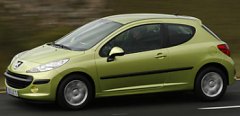 In the
mechanical side, it is more middle-of-the-road. These days Peugeot is
very conservative in mechanical design. It follows the popular trend of
using MacPherson struts and torsion-beam suspensions and an electric
power steering, as it is built on the same platform as 1007 and Citroen
C2 / C3. In fact, I can’t find any technical details worth special
note. In the
mechanical side, it is more middle-of-the-road. These days Peugeot is
very conservative in mechanical design. It follows the popular trend of
using MacPherson struts and torsion-beam suspensions and an electric
power steering, as it is built on the same platform as 1007 and Citroen
C2 / C3. In fact, I can’t find any technical details worth special
note.
Well, perhaps except size. The 207 has grown a lot in size – a massive
200 mm longer, 70 mm wider and 40 mm taller than the 206, while the
wheelbase is 100 mm longer !! to shock you, it is actually bigger than
the old 306. Is it really a supermini ?
 Such
doubt can also be found at the scale. The lightest 207 weighs 1150 kg
while the heaviest (with diesel engine) stands at 1250 kg. In other
words, it gained about 150 kg from its predecessor, in which 40 kg
comes from the extra size, 60 kg from extra safety improvements and the
rest from upgraded comfort features. Talking about safety, the car must
be proud of having a torsional rigidity of 21,820 Nm / degree.
Considering an Opel Vectra is 18,000 Nm/degree, this is remarkable for
a hatchback. No wonder it achieved 5-star Euro NCAP result. Such
doubt can also be found at the scale. The lightest 207 weighs 1150 kg
while the heaviest (with diesel engine) stands at 1250 kg. In other
words, it gained about 150 kg from its predecessor, in which 40 kg
comes from the extra size, 60 kg from extra safety improvements and the
rest from upgraded comfort features. Talking about safety, the car must
be proud of having a torsional rigidity of 21,820 Nm / degree.
Considering an Opel Vectra is 18,000 Nm/degree, this is remarkable for
a hatchback. No wonder it achieved 5-star Euro NCAP result.
On the road, the Peugeot “big mini” feels sportier than its key rivals,
Renault Clio and Fiat Grande Punto. It corners more flatly, thanks to a
harder suspension setting and wider tracks. Its electric power steering
betters rival systems by offering decent feedback and weighting,
although it is no match with the legendary 205. Peugeot wants to
establish a sportier image than Citroen and other mainstream rivals, so
it tuned the 207 in favour of keen drivers. On the down side, the car
rides harder than Renault and Fiat.
 Nevertheless,
the 207 misses one important thing to please keen drivers: power. At
launch, the 207 offers 3 petrol and 3 diesel engines: 1.4-litre 75hp 8V
petrol, 1.4-litre 88hp 16V CVVT petrol, 1.6-litre 110hp 16V petrol,
1.4-litre 70hp turbo diesel, 1.6-litre 90 hp turbo diesel and 1.6-litre
110hp VTG turbo diesel. My preference is the 1.4-litre 16V CVVT, for it
is more refined than the bigger petrol while its lightweight aluminum
block benefits handling. Unfortunately, it is not powerful enough to
push the “big mini”, taking 12 long seconds to complete 0-60 mph
acceleration. In real world, the two larger diesel engines might be a
better bet, but they are pretty expensive. Nevertheless,
the 207 misses one important thing to please keen drivers: power. At
launch, the 207 offers 3 petrol and 3 diesel engines: 1.4-litre 75hp 8V
petrol, 1.4-litre 88hp 16V CVVT petrol, 1.6-litre 110hp 16V petrol,
1.4-litre 70hp turbo diesel, 1.6-litre 90 hp turbo diesel and 1.6-litre
110hp VTG turbo diesel. My preference is the 1.4-litre 16V CVVT, for it
is more refined than the bigger petrol while its lightweight aluminum
block benefits handling. Unfortunately, it is not powerful enough to
push the “big mini”, taking 12 long seconds to complete 0-60 mph
acceleration. In real world, the two larger diesel engines might be a
better bet, but they are pretty expensive.
Another weakness is gearbox. The old 5-speed manual gearbox has a
notchy gearshift. However, both the engine and gearbox problems are
likely to be solved next year when a new BMW-designed 1.6-litre engine
and 6-speed manual gearbox join the range. Because the combo will be
shared with the new Mini, I am confident that it will be nothing but
excellent.
 Open the
doors and enter the cabin, you will see Peugeot has upgraded the
quality standard but it still trails Renault, nor its visual appeal can
match the colorful Fiat Grande Punto. The dashboard design is perhaps
slightly ordinary. The driving position has been improved, thanks to a
fully adjustable steering wheel. Space-wise, 207 once again proves that
Peugeot is not good at packaging efficiency. Despite of the jumbo
exterior dimensions, the interior space is just average. The fast
windscreen leads to a less spacious feel for the front occupants. The
rear seats can only take 2 adults because the side windows are heavily
curved inside. Moreover, rear legroom is more compromised than Punto
and Clio. To compensate, Peugeot offers a lot of big car equipment,
such as color screen for sat-nav, a panoramic glass roof, a superb
8-speaker Hi-Fi, cruise control, dual zone climate control, Bluetooth
connectivity, tire pressure monitors… Open the
doors and enter the cabin, you will see Peugeot has upgraded the
quality standard but it still trails Renault, nor its visual appeal can
match the colorful Fiat Grande Punto. The dashboard design is perhaps
slightly ordinary. The driving position has been improved, thanks to a
fully adjustable steering wheel. Space-wise, 207 once again proves that
Peugeot is not good at packaging efficiency. Despite of the jumbo
exterior dimensions, the interior space is just average. The fast
windscreen leads to a less spacious feel for the front occupants. The
rear seats can only take 2 adults because the side windows are heavily
curved inside. Moreover, rear legroom is more compromised than Punto
and Clio. To compensate, Peugeot offers a lot of big car equipment,
such as color screen for sat-nav, a panoramic glass roof, a superb
8-speaker Hi-Fi, cruise control, dual zone climate control, Bluetooth
connectivity, tire pressure monitors…
To most mini car buyers, the packaging weakness and hard ride quality
make 207 less appealing than its key rivals. To keen drivers, its
engine and gearshift takes its edge off. Before the BMW engine and
gearbox arrive, 207 can only be described as a fine car, but not a
remarkable car. Well, the outgoing 206 was also far from first-class.
In fact, its main virtue was a beautiful styling. Once people loved its
look, they accepted all other average aspects. The new car also got a
pretty look. Will it repeat the success of its predecessor? We shall
see. |
| The
above report was last updated on 24 Apr
2006. All Rights Reserved. |
207GT Turbo
|
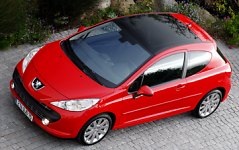 In
my last Peugeot 207 report the biggest criticism was the lack of good
engines and gearboxes, but I also wrote "both the engine and
gearbox problems are likely to be solved next year when a new
BMW-designed 1.6-litre engine and 6-speed manual gearbox join the
range. Because the combo will be shared with the new Mini, I am
confident that it will be nothing but excellent." This is proved to be
true today with the launch of 207 GT Turbo ! In
my last Peugeot 207 report the biggest criticism was the lack of good
engines and gearboxes, but I also wrote "both the engine and
gearbox problems are likely to be solved next year when a new
BMW-designed 1.6-litre engine and 6-speed manual gearbox join the
range. Because the combo will be shared with the new Mini, I am
confident that it will be nothing but excellent." This is proved to be
true today with the launch of 207 GT Turbo !
The 207GT Turbo replaces 206GTi (206RC) as the company's best selling
hot hatch. Power comes from BMW's new 1598cc four-cylinder engine with
twin-cam 16 valves, continuous VVT at the intake camshaft, direct
injection and a twin-scroll turbocharger. A relatively small turbo
(boost pressure max 0.8 bar) and the cooling effect of direct fuel
injection allows an unusually high compression ratio of 10.5:1,
benefiting off-boost power. It produces 150 horsepower at 5800 rpm,
13hp more than the old 206GTi, yet returns better fuel consumption at
40.3 mpg, up from 36.6 mpg despite of the larger and heavier 207 body.
All these facts and figures demonstrate the engineering power of BMW.
If it were developed by Peugeot itself, can you imagine it would be
this advanced ?
On the road, this is a very tractable engine with instantaneous
throttle response and almost no detectable turbo lag. It pulls strongly
right from idle, thanks to a strong torque curve peak at 177 lbft from
just 1400 rpm to 3500 rpm. That comes 30 lbft more and 2000 rpm earlier
than class norm ! the willingness means it is easy to get the 207GT
Turbo to 131 mph and 0-60 mph in 7.7 seconds without working hard on
rev and gearshift. That's a sharp contrast to the naturally aspirated
rivals like Renault Clio RS and Honda Civic Type R. With so much torque
from bottom end, you can easily forgive the 5-speed gearbox for not
delivering the slickest and swiftest gearshifts.
There is some drawback though. The engine is tuned to bias towards low
to mid-range output, therefore it is not very willing to rev beyond
5500 rpm, at which point you can hear a booming resonance protesting
your abuse. If you want a more eager top end performance, Peugeot will
advise you to wait for next year's hotter version, which will be
powered by the 175hp version of the engine. For now, I would say the
150hp engine is lovely enough for most circumstances.
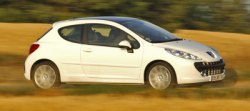 The chassis is also a success.
After the disappointing 206GTI 180, we are glad that Peugeot is back on
form in the tuning of 207GT Turbo. It gave the car harder front
suspension bushings, stiffer torsion beam at the rear suspension and
firmer dampers. It corners flat and overcomes bumps with controlled
suppleness. Its nose turns eagerly into corners, a reflection of the
lightweight engine (aluminum block makes it even lighter than the
regular 207's naturally-aspirated 110hp 1.6) and fine suspension
geometry. The steering is the best ever electric power steering we have
seen. It is not only responsive and accurate, but most important it
loads up beautifully in corners to tell the driver how close it comes
to the limit. This kind of feedback has been lost in most other hot
hatches. Another waning talent you can find in 207GT Turbo is throttle
steer. If you back off throttle mid-corner, it will induce a touch
oversteer. It brings back the memory of 205GTi, but the way it
oversteer is progressive and gentle, and is backed up by ESP as the
ultimate safety net. Peugeot has hit the right balance between driving
fun and safety. The chassis is also a success.
After the disappointing 206GTI 180, we are glad that Peugeot is back on
form in the tuning of 207GT Turbo. It gave the car harder front
suspension bushings, stiffer torsion beam at the rear suspension and
firmer dampers. It corners flat and overcomes bumps with controlled
suppleness. Its nose turns eagerly into corners, a reflection of the
lightweight engine (aluminum block makes it even lighter than the
regular 207's naturally-aspirated 110hp 1.6) and fine suspension
geometry. The steering is the best ever electric power steering we have
seen. It is not only responsive and accurate, but most important it
loads up beautifully in corners to tell the driver how close it comes
to the limit. This kind of feedback has been lost in most other hot
hatches. Another waning talent you can find in 207GT Turbo is throttle
steer. If you back off throttle mid-corner, it will induce a touch
oversteer. It brings back the memory of 205GTi, but the way it
oversteer is progressive and gentle, and is backed up by ESP as the
ultimate safety net. Peugeot has hit the right balance between driving
fun and safety.
As an everyday car, 207GT Turbo is better than Renault Clio RS because
of its more accessible performance. It is also cheaper to buy
(£14,400 vs £16,000) and cheaper to run. However, the Clio
is ultimately faster, sportier and cooler to look. Whether it can stand
the next attack from Peugeot's 175hp model remains to be seen.
|
| The
above report was last updated on 27 Sep
2006. All Rights Reserved. |
207RC (GTi)
|
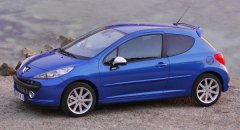 The
150hp 207GT Turbo is one of our favourite hot hatches despite of its
lukewarm performance. Now, with 25 more horsepower and sportier
suspensions, can the range-topping 207RC (or 207GTi for UK market) put
Peugeot back to the top of the hot hatch world? The
150hp 207GT Turbo is one of our favourite hot hatches despite of its
lukewarm performance. Now, with 25 more horsepower and sportier
suspensions, can the range-topping 207RC (or 207GTi for UK market) put
Peugeot back to the top of the hot hatch world?
Before answering this question, let's look at the car first. 207RC is
surprisingly close to 207GT Turbo. Externally, the only noticeable
change is the tailgate spoiler. There are no bigger wheels or wider
tires. No fancy air dam, skirts or ventilation holes. For a range
topper it is surprisingly understated. Inside, the grey dashboard is
quite boring. Nothing can make you wow. There are a pair of heavily
bolstered bucket seats, but they are trimmed in grey Alcantara to
continue the boring story. In comparison, the cabin of Opel Corsa OPC
looks far more attractive. Nevertheless, function-wise this cabin works
very well: the driving position is excellent; the bucket seats
are very supportive; the equipment list is generous. Modern day hot
hatches won't punish their drivers anymore.
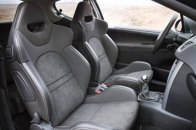 Open
the bonnet, the engine is again indistinguishable from the 207GT Turbo.
In fact, this is the same BMW-developed 1.6-liter 16V direct injection
turbo engine as its smaller brother. The only difference is higher
boost pressure (now 0.8 bar or 1.0 bar on overboost) and a turbine
housing made of steel, which is more heat resisting than cast iron.
What a cheap way to deliberate another 25 horsepower ! The engine
produces 175 hp at 6000 rpm, but the most impressive is again its
torque delivery - 177 lbft from 1600 to 4500 rpm. The direct injection,
which enables 10.5:1 compression, twin-scroll turbocharger and
continuous intake variable valve timing contribute to this impressive
torque spread. They also eliminate any turbo lag. From as low as 1000
rpm, the engine comes alive and keeps pulling right until the 6500 rpm
cut-out without any discernible tail-out. Impressive. Open
the bonnet, the engine is again indistinguishable from the 207GT Turbo.
In fact, this is the same BMW-developed 1.6-liter 16V direct injection
turbo engine as its smaller brother. The only difference is higher
boost pressure (now 0.8 bar or 1.0 bar on overboost) and a turbine
housing made of steel, which is more heat resisting than cast iron.
What a cheap way to deliberate another 25 horsepower ! The engine
produces 175 hp at 6000 rpm, but the most impressive is again its
torque delivery - 177 lbft from 1600 to 4500 rpm. The direct injection,
which enables 10.5:1 compression, twin-scroll turbocharger and
continuous intake variable valve timing contribute to this impressive
torque spread. They also eliminate any turbo lag. From as low as 1000
rpm, the engine comes alive and keeps pulling right until the 6500 rpm
cut-out without any discernible tail-out. Impressive.
Unusually,
the overboost facility has no time limit, an evidence that the engine
has great potential for tuning. As long as the gearbox is in one of the
top three gears, overboost can increase maximum torque to 192 lbft.
However, even without using the overboost function, 207RC is capable to
accelerate from rest to 60 mph in 6.8 seconds, matching the more
powerful Clio RS and Corsa OPC. Praise must go to the flexible engine
and sensible gearing.
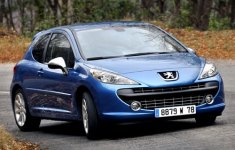 Talking about gearing, we are
surprised that Peugeot equipped the 207RC with the same 5-speed gearbox
as 207GT Turbo rather than a more fashionable 6-speeder. Admittedly,
for a hot hatch whose top speed is only 137 mph and has an engine so
flexible, a 6-speeder is not only useless but it actually requires more
shifts thus leads to more interruption. That is bad for both
acceleration and driving pleasure. Peugeot sensibly avoided the
temptation of 6-speed gearbox and goes the traditional route. The RC's
5-speed manual has a longer first gear for attacking hairpins and
shorter ratios for the remaining gears. These ratios were found very
suitable to twisty back roads, giving the 207RC a lively real world
performance. What a pity the gearshift quality is too rubbery, too
imprecise for busy work. Talking about gearing, we are
surprised that Peugeot equipped the 207RC with the same 5-speed gearbox
as 207GT Turbo rather than a more fashionable 6-speeder. Admittedly,
for a hot hatch whose top speed is only 137 mph and has an engine so
flexible, a 6-speeder is not only useless but it actually requires more
shifts thus leads to more interruption. That is bad for both
acceleration and driving pleasure. Peugeot sensibly avoided the
temptation of 6-speed gearbox and goes the traditional route. The RC's
5-speed manual has a longer first gear for attacking hairpins and
shorter ratios for the remaining gears. These ratios were found very
suitable to twisty back roads, giving the 207RC a lively real world
performance. What a pity the gearshift quality is too rubbery, too
imprecise for busy work.
Compare
with 207GT Turbo, the suspension beef up includes a 30 percent stiffer
torsion beam at the rear axle, stiffer springs and harder bushings at
the front MacPherson struts. The conversion successfully tightens its
body control while still leaves pretty good ride comfort. 207RC is a
safe-handling machine. If you lift off the throttle in a bend, it will
tighten its nose a little bit but the tail will not step out like the
legendary 205GTi. Such well-tamed manner and the abundance of grip make
it easy to drive fluently in the twisties, especially when the engine
and gearing are so cooperative. The electric power steering is also the
best of its kind, offering good weighting and consistent feedback from
the front rubbers.
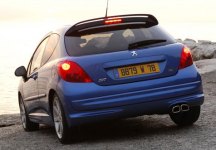 Critics
like to compare it with the great 205GTi. Perhaps it's time to wake up
from dreams. Modern hot hatches can no longer follow the footprints of
205GTi to use unassisted steering or hydraulic power steering as they
are costly and energy inefficient. Nor can they tip the scale at under
1000 kg. All the safety structure and comfort features put an extra 250
kg to the 207RC, robbing it sharp feedback and instantaneously
response. And then our modern drivers ask for easier and safer
handling… Look at Clio RS, Corsa OPC or Mini Cooper S, everybody else
are heading to the modern way. It's not fair to criticize 207RC just
because it is the grandson of 205GTi. Critics
like to compare it with the great 205GTi. Perhaps it's time to wake up
from dreams. Modern hot hatches can no longer follow the footprints of
205GTi to use unassisted steering or hydraulic power steering as they
are costly and energy inefficient. Nor can they tip the scale at under
1000 kg. All the safety structure and comfort features put an extra 250
kg to the 207RC, robbing it sharp feedback and instantaneously
response. And then our modern drivers ask for easier and safer
handling… Look at Clio RS, Corsa OPC or Mini Cooper S, everybody else
are heading to the modern way. It's not fair to criticize 207RC just
because it is the grandson of 205GTi.
If you can forget the history of hot Peugeots, you will be able to
appreciate 207RC. It is fast and fun to drive in back roads. It is very
user friendly. It is cheaper to buy than the aforementioned rivals and
is also very cheap to run, with an excellent combined consumption of
39.2 mpg. Of course, it is not perfect. More power and a more striking
look would have made it even better. Given the existence of 207GT
Turbo, Peugeot could have done more. |
| The
above report was last updated on 23 Apr
2007. All Rights Reserved. |
207CC
|
 6
years ago, Peugeot and its supplier Heuliez stunned the world by
offering a retractable metal roof in 206CC. No one else could believe a
car so small and so affordable could employ such a classy technology.
The car dominated a segment it created in the following years. Some
366,000 cars were sold and, at its peak, around 100,000 units were
built annually ! the great success changed the landscape of the
cabriolet market in Europe and even propagated to Japan (see Daihatsu
Copen) and America (Pontiac G6 Convertible). Today, coupe-cabriolet – a
term invented by Peugeot – has replaced conventional soft-top cabriolet
as the market trend. Countless of competitors joined the battlefield,
such as VW Eos, Volvo C70, Ford Focus CC, Nissan Micra C+C, Mitsubishi
Colt CZC, Opel Tigra and Astra TwinTop, Renault Megane CC, BMW 3-Series
Cabriolet and Peugeot's own 307CC. 6
years ago, Peugeot and its supplier Heuliez stunned the world by
offering a retractable metal roof in 206CC. No one else could believe a
car so small and so affordable could employ such a classy technology.
The car dominated a segment it created in the following years. Some
366,000 cars were sold and, at its peak, around 100,000 units were
built annually ! the great success changed the landscape of the
cabriolet market in Europe and even propagated to Japan (see Daihatsu
Copen) and America (Pontiac G6 Convertible). Today, coupe-cabriolet – a
term invented by Peugeot – has replaced conventional soft-top cabriolet
as the market trend. Countless of competitors joined the battlefield,
such as VW Eos, Volvo C70, Ford Focus CC, Nissan Micra C+C, Mitsubishi
Colt CZC, Opel Tigra and Astra TwinTop, Renault Megane CC, BMW 3-Series
Cabriolet and Peugeot's own 307CC.
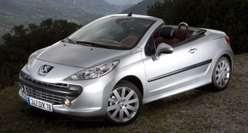 Following the retirement of 206
range (at least in wealthier markets), the place of 206CC has been
succeeded by 207CC. The new car is no longer revolutionary, but it has
sorted out the problems of the old car and refined the roof. The roof
is now made in-house at Peugeot's plant in Spain together with the
assembly line of 207CC, although the electro-hydraulic actuating
mechanism is still supplied by Heuliez. Lessons learned from the old
car helped improving the sealing and reliability of the system. It also
eliminated the need for manually latching between the windscreen header
and the roof. This mean, the only action you need is to press the
button, then the roof will open and store into the boot automatically
in 25 seconds. Following the retirement of 206
range (at least in wealthier markets), the place of 206CC has been
succeeded by 207CC. The new car is no longer revolutionary, but it has
sorted out the problems of the old car and refined the roof. The roof
is now made in-house at Peugeot's plant in Spain together with the
assembly line of 207CC, although the electro-hydraulic actuating
mechanism is still supplied by Heuliez. Lessons learned from the old
car helped improving the sealing and reliability of the system. It also
eliminated the need for manually latching between the windscreen header
and the roof. This mean, the only action you need is to press the
button, then the roof will open and store into the boot automatically
in 25 seconds.
You
might notice that the roof is still a simple and cheap two-piece
design. This result in a header rail located fairly close to your head,
and the boot looks quite long compare with the passenger compartment.
Never mind, at this price you can't ask for a multiple-piece roof like
Volvo C70 or Volkswagen Eos, as these cars cost significantly more and
occupy a higher segment. The beauty of 207CC is that it offers
coupe-cabriolet experience to the majority rather than asking you to
pay more.
Despite of the low asking price, the 207CC offers very good refinement
and safety. Its chassis is a lot stronger than its predecessor,
achieving a torsional rigidity of 17,500 Nm / degree when the roof is
up or 11,600 Nm / degree when the roof is down. That compares
favourably with most coupe-cabriolets and you can feel it on the road.
With the roof up, there is no scuttle shake and little noise can enter
the cabin. Safety features include front and side air bags, ESP
stability control and a pair of rollover protection bars popped up from
behind the cabin in 175ms.
The cockpit of 207CC can be stylish if you specify leather trim which
covers the whole dash top, door panels, seats and part of the steering
wheel. Driving position is perfect compare with 206CC. Predictably, the
cabin is only suitable to 2 adults plus 2 handicapped at the back,
because
of the limited legroom and the small roof eating seriously into
headroom. The 2-piece metal roof also engages a lot of luggage space
when it is folded, reducing boot volume from 370 liters to 145 liters.
The latter is also very difficult to access due to the narrow opening
underneath the folded roof. Perhaps this is why the CC is offered with
the small rear seats – they are often used as luggage space.
 Never
mind. Most buyers of the CC are believed to be single women. They care
more about a pretty look – the 207CC does look stylish – and ride
refinement – it does ride well. However, it is not an engaging drive.
The CC conversion added an astonishing 210 kg to the car (while 206CC
added only 120 kg to its equivalent hatchback version). This blunts its
performance and takes the sharp edge off its handling. In isolation,
the engines are good. BMW supplies both gasoline engines from its new
Mini – the 150hp light-pressure turbocharged 1.6-litre with VVT and
direct injection, and the naturally-aspirated 120hp 1.6-litre with VVT
and Valvetronic. Both are smooth and willing, but even the turbo
engine's wide spread of torque (177 lbft from 1400 rpm to 3500 rpm)
cannot put a thrilling laugh on the face of its driver, as it takes 8.3
seconds to accelerate from 0-60 mph. On the other hand, PSA's own 110hp
1.6HDi engine is best reserved to those who prefer driving leisurely. Never
mind. Most buyers of the CC are believed to be single women. They care
more about a pretty look – the 207CC does look stylish – and ride
refinement – it does ride well. However, it is not an engaging drive.
The CC conversion added an astonishing 210 kg to the car (while 206CC
added only 120 kg to its equivalent hatchback version). This blunts its
performance and takes the sharp edge off its handling. In isolation,
the engines are good. BMW supplies both gasoline engines from its new
Mini – the 150hp light-pressure turbocharged 1.6-litre with VVT and
direct injection, and the naturally-aspirated 120hp 1.6-litre with VVT
and Valvetronic. Both are smooth and willing, but even the turbo
engine's wide spread of torque (177 lbft from 1400 rpm to 3500 rpm)
cannot put a thrilling laugh on the face of its driver, as it takes 8.3
seconds to accelerate from 0-60 mph. On the other hand, PSA's own 110hp
1.6HDi engine is best reserved to those who prefer driving leisurely.
Frankly, few coupe cabriolets can escape from similar conclusions. Even
as brilliant as BMW 3-Series Cabriolet, they cannot overcome the weight
penalty due to the hefty roof mechanism and chassis reinforcement.
However, the most important to Peugeot is: 207CC combines the benefit
of coupe-cabriolet in a package with good look, high chassis integrity,
refinement and safety, and still offered at a very affordable price. It
may not match the success of 206CC, but it will doubtedly be a big
seller. |
| The
above report was last updated on 12 Feb
2007. All Rights Reserved. |
|
|